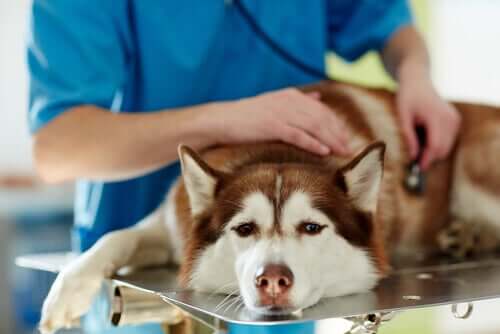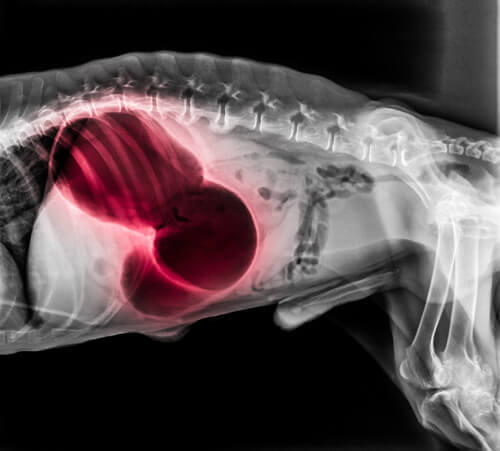Blood Clots and Their Risks to Dogs

One of the main processes of the circulatory system is the ability to clot blood. This is because coagulation is vital for proper wound healing and the normal recovery of scrapes, cuts and other forms of damage, both on the skin and in the internal organs. However, when blood clots form in the wrong places or for the wrong reason they can pose a serious health risk to an animal.
Why are blood clots risky?
The main risk is due to a clot’s ability to stop blood circulation, thus preventing oxygen from reaching all tissues.
You must keep in mind that a clot can lead to a stroke and other acute, life-threatening conditions.
The specific symptoms of blood clots vary depending on they are. Because they could be lethal to dogs, you must immediately consult a vet if you suspect they may have them, as the animal could be at risk of thrombosis.
Knowing the risk factors for the formation of blood clots or thrombi can help you identify a potential problem well in advance so you can take quick action.
Why do blood clots form?

There are many different situations that could lead to a thrombosis. For example, staying in the same position for long periods of time is a predisposing factor. Other possible causes of thrombosis in dogs are:
- Not moving much during recovery from surgery and, in general, a sedentary lifestyle.
- Autoimmune disorders: the formation of antigen-antibody complexes in the circulation can lead to the formation of clots.
- Some forms of hypothyroidism.
- Any condition that affects the bone marrow, such as leukemia.
- Circulatory disorders.
We must highlight that these are just some of the situations that could increase the risk of thrombus formation in your dog.
Symptoms of blood clots in dogs
The symptoms of a thrombosis in dogs will often be very difficult to detect until these become acute and problematic. Recently, there’s been an effort, through many lab tests, to identify the risk of thrombosis in dogs.
It’s necessary to recognize that, because a thrombus can happen in any area of the body, the symptoms vary considerably.
Blood clots in their extremities
When a thrombus forms in one of the dog’s legs or their tail, it can decrease the temperature of the affected area and cause possible subsequent paralysis. The dog may experience a tingling pins-like sensation in them, and so they’ll most likely try to shake them to obtain relief.
If there’s a clot, such movements can cause it to move to another area of the body and this could have bad consequences.
In their heart or lungs

A clot in the heart or the lungs could bring a variety of serious systemic symptoms, including fainting, shortness of breath and paralysis. Also, the dog’s gums might be pale or blue and they may not be able to sleep. And, they might also begin to cough up blood. Pulmonary thromboembolism is usually fatal.
In their brain
Brain blood clots lead to vascular accidents or strokes. The symptoms vary depending on where in the brain they lodge. In general, the animal will lose their reflexes.
For example, your dog may behave strangely and bang their head against the wall or some other object for apparently no reason. Their eyes may also go out of whack and display vestibulo-ocular eye movements, tremors, and seizures.
Treatment for blood clots
If you suspect that your dog may have developed a thrombus, try to keep them as still as possible and consult your vet immediately. They’ll, most likely, advise you on how to safely transfer the animal to your nearest clinic, and then quickly administer a combination of anticoagulants and fluid therapy.
The treatment of a thrombus is risky. In addition, blood clot formation may be associated with a variety of diseases. And, in these cases, the clots often recur if the underlying cause isn’t completely resolved.
In short, there’s a risk of death when blood clots form. Unfortunately, there’s no set of specific symptoms that could warn about their formation. The timely identification of thrombus formation depends largely on knowing what the predisposing risk factors are. Also about the symptoms they bring along.
All cited sources were thoroughly reviewed by our team to ensure their quality, reliability, currency, and validity. The bibliography of this article was considered reliable and of academic or scientific accuracy.
- Johnson, L. R., Lappin, M. R., & Baker, D. C. (1999). Pulmonary thromboembolism in 29 dogs: 1985–1995. Journal of veterinary internal medicine, 13(4), 338-345.
- Williams, T. P., Shaw, S., Porter, A., & Berkwitt, L. (2017). Aortic thrombosis in dogs. Journal of veterinary emergency and critical care, 27(1), 9-22.
- Jeffery, U., Staber, J., & LeVine, D. (2016). Using the laboratory to predict thrombosis in dogs: An achievable goal?. The Veterinary Journal, 215, 10-20.
- Rodríguez, A. S., García-Sancho, M., Bertos, A. R., Rodríguez-Franco, A., & Fernández, A. V. (2010). Pulmonary thromboembolism in a dog with inflammatory bowel disease. Revista complutense de ciencias veterinarias, 4(2), 78-86.
